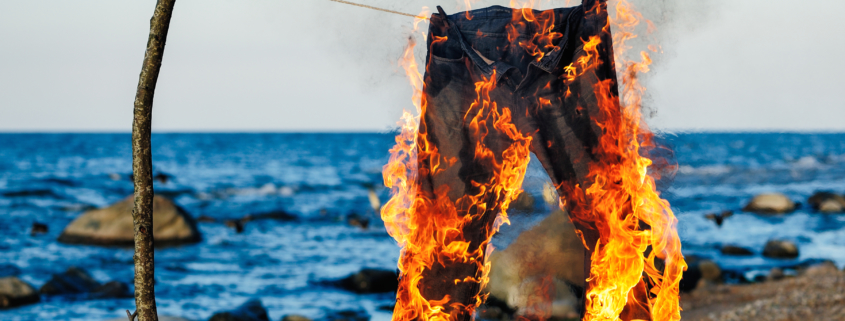Companies may use flammable clothing materials to save money. But what you may not know is that the United States does not require all clothing to be completely flame resistant. That means that many items of clothing in our closets right now are flammable and can cause injury if they catch fire.
If you or a loved one have been injured due to a defective product with flammable clothing material, you need to speak with an experienced Florida product liability attorney.
The team at Lytal, Reiter, Smith, Ivey & Fronrath can help you get justice for the pain you’ve suffered. We hold the big companies accountable for their actions against the consumer. Call for a free consultation today.
Flammable Clothing Regulations
The Federal Flammability Standard Regulations states that children’s sleepwear cannot be made of fabrics that will catch fire and cause burn injury. The flammable material must meet certain standards of durability and flame resistance.
When clothes are made of bad material or when they were made carelessly, companies can be held responsible for injuries.
In the United States, the Consumer Product Safety Commission regulates goods in the marketplace. They require that clothing materials pass flammability tests. However, there is an increasing number of product liability cases annually due to negligent manufacturing processes and the use of flammable materials.
To try to protect the public, the government has classified flammable fabrics into three categories:
1) Normal flammability
2) Intermediate Flammability
3) Rapid and Intense Burning.
Class 3 fabrics are highly regulated and are prohibited from being used for clothing in the United States.
Flammable Materials
Flammable clothing material is made of many types of fibers which can easily ignite and cause product defects.
It is important to be aware of the types of fabric and their known reaction to flame. To determine whether an article of clothing is a fire hazard, you must look at three things:
- Type of material
- Weight of the product
- How it is constructed or manufactured
Different materials burn in different ways. The weave can determine the behavior in a product fire. For example, knitted products are less flammable than woven products.
Materials such as cotton and linen have a loose weave, so they burn quickly. Synthetic fibers can melt into the skin. Wool and silk have a tight weave, which makes them more flame resistant and slower-burning.
Wearing tight-fitting clothing, such as spandex, can reduce flammability. Clothing that fits tightly to the body is less likely to ignite.
Cases of Flammable Clothing Material
Victoria’s Secret Lawsuit
In 2017, a woman sued the popular women’s underwear company, Victoria’s Secret, for selling a defective bra with flammable materials. The plaintiff purchased a Victoria’s Secret demi bra in 2015. She then suffered burns and blisters after the bra “leaked and exploded” with a fluid.
The bra has since been taken off the market with no reason given.
Victoria’s Secret has a long history of being targeted by product liability lawsuits for clothing that burns consumers.
Amazon Recall
In 2021, the United States Consumer Product Safety Commission filed a claim against the online retailer, Amazon, for selling defective products. Among the hundreds of thousands of products sold were flammable sleepwear for children.
Although the sleepwear was offered by third parties, the US has laws regarding importing these items into the country, as they obviously fail to comply with local legislation.
Amazon was forced to pay customers up to $1,000 for the sale of these hazardous materials. They will be held liable for any damages that individuals suffered, on top of this settlement amount.
Nordstrom Recall
In 2014, Nordstrom recalled their Textured Open Tunic Vest after it failed the Federal Flammability Standard. The recall included the return of over 2,000 sweaters that retailed at $70. The recall was announced prior to any injuries being reported but cost the company dearly in returns.
Had the product stayed on the market, it could have eventually caused severe burns to the individuals wearing it.
L.L. Bean Pajamas Recall
In 2013, L.L. Bean recalled 800 sets of children’s pajamas. They violated the Federal Flammability Standard and put children at serious risk for a burn-related injury.
Testing is required before children’s clothes hit the market to ensure that the materials stand up to the strict guidelines for the fabrics. These include testing the tightness of the material and how flammable the weave is.
L.L. Bean was not alone in this 2013 recall. Nine other recalls were issued the same year for violations of children’s flammable clothing standards.
How to Avoid Flammable Clothing Materials
By being aware of the product you are purchasing, you can avoid flammable clothing materials.
- Watch for words on product packaging’s warning label that include “flammable,” “combustible,” or “flash.”
- Avoid products that do not have safety labels.
- Once you purchase clothing, be sure to keep them away from flames or heaters, just in case. Even flame-resistant fabrics can catch fire.
- Ensure that your smoke detectors are working properly. Teach your children about fire safety. Be sure you have a system in your house for dousing flames.
Contact a Product Liability Lawyer
If you have been injured due to flammable clothing material used to make a defective product, contact Lytal, Reiter, Smith, Ivey & Fronrath today.
Call (561) 655-1990 today. Our product liability lawyers will help you remove a dangerous product from the market and keep others safe.




